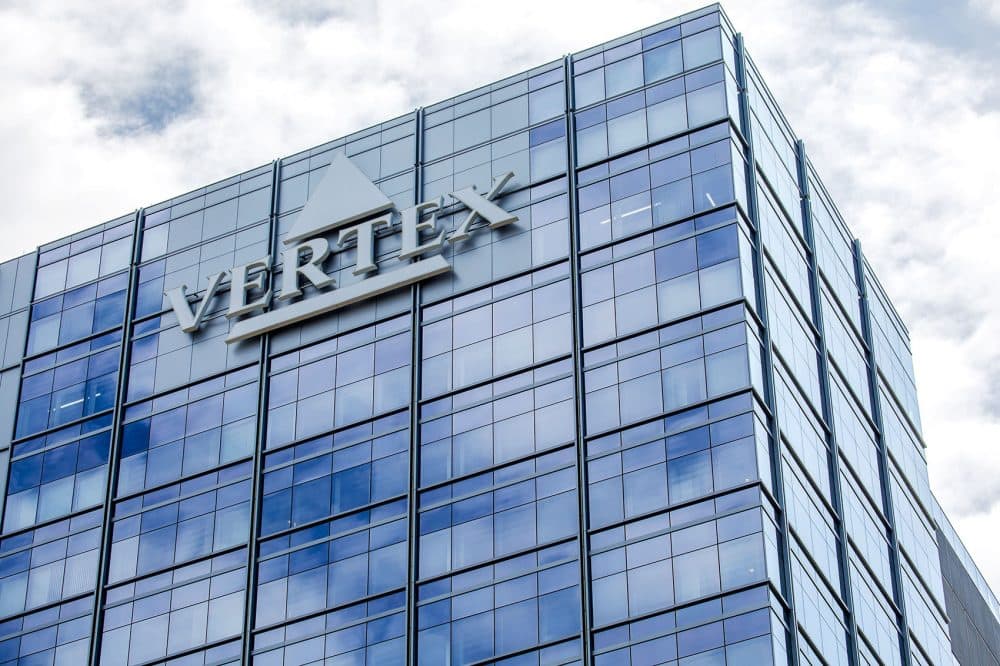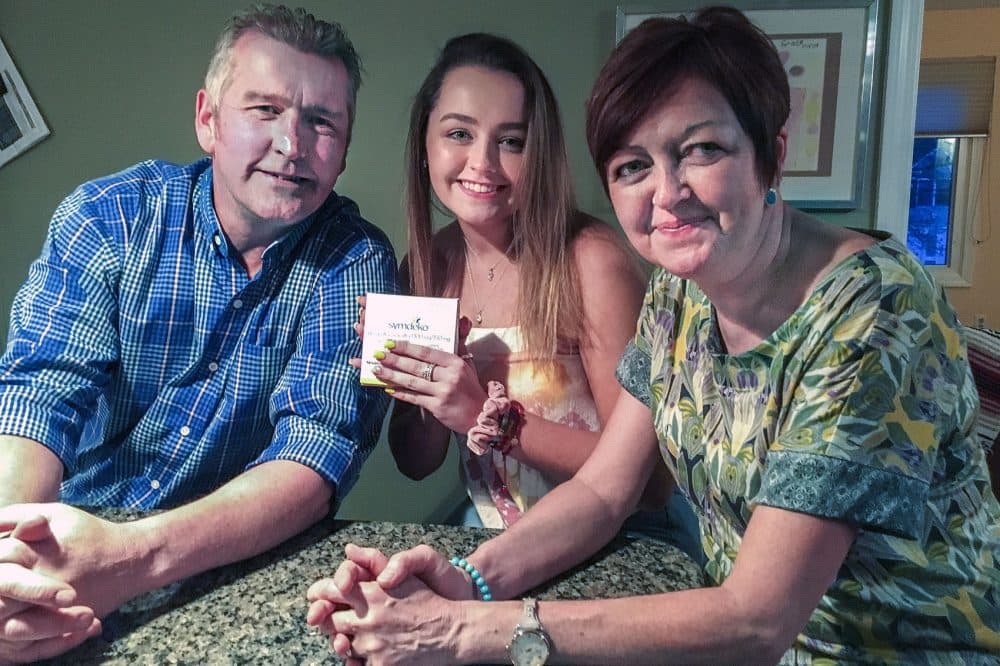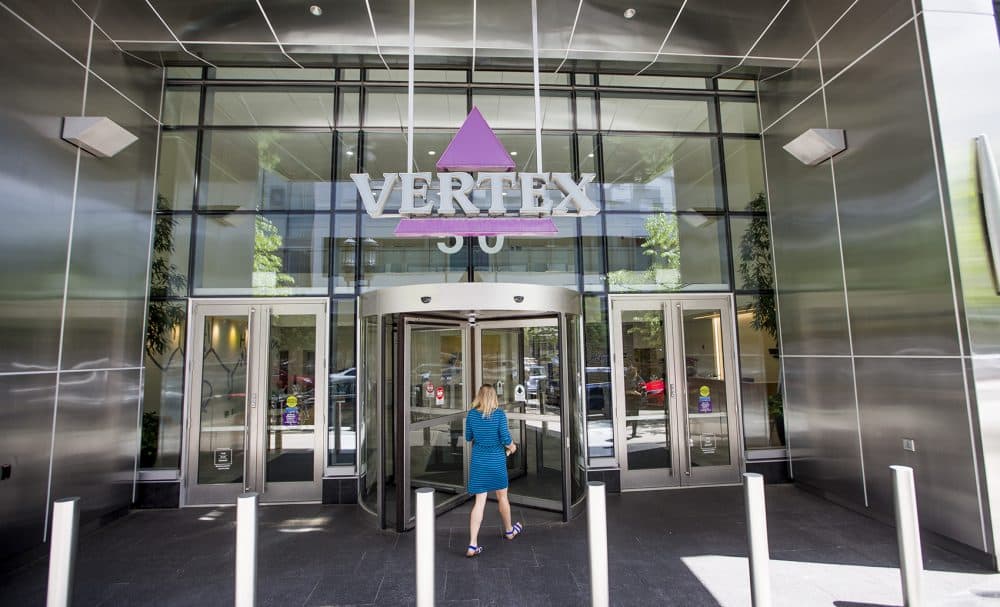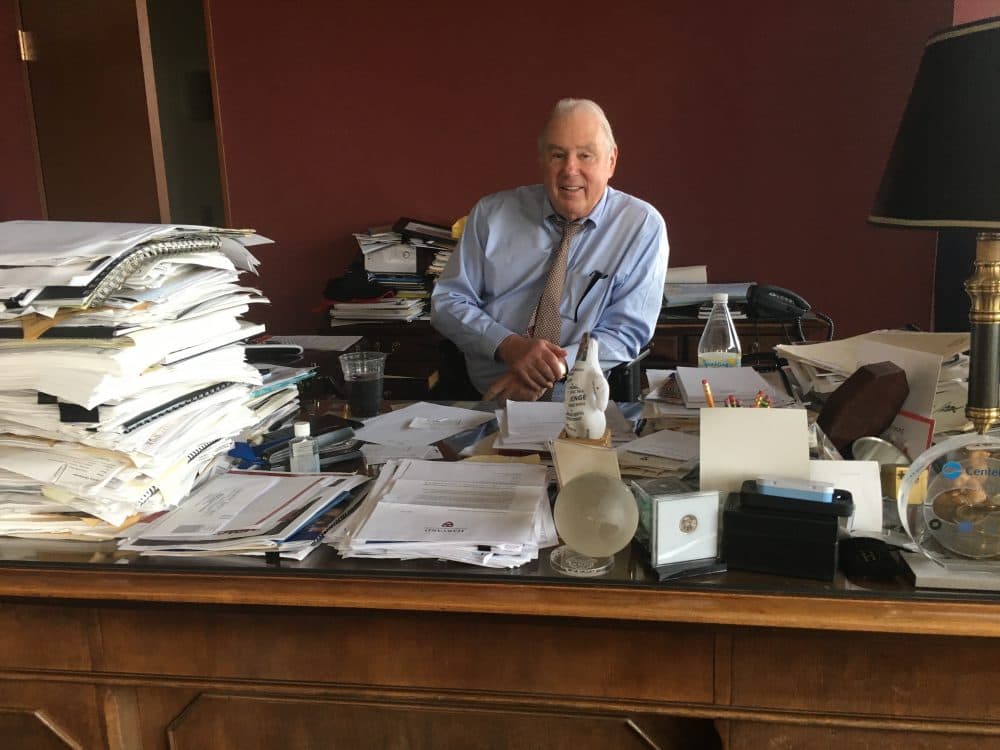Advertisement
BioBoom
Boston's Vertex Has Taken A Roller Coaster Ride To Profitability
Resume
Editor's Note: Vertex is a WBUR underwriter but has no role in editorial decisions.
Vertex Pharmaceuticals is one of Massachusetts' oldest, largest and most successful biotech companies. Fifteen hundred workers occupy two buildings in Boston's gleaming, high-tech Seaport District. The median salary at the company is north of $210,000.
In recent years the company's stock has soared; the share price doubled last year. But the path to Vertex's profitability has been volatile, marked by soaring, successful drug trials, steep market declines and death-defying financial tribulations.
Along the way Vertex got a lucky boost from a unique funding source and, as a result, developed an unusual business model.
But the company now faces perhaps its greatest challenge: resistance to the cost of its groundbreaking drugs.
Testing The Luck Of The Irish
Lillian and Tim O'Leary and their daughter Grace gather around the kitchen counter in their North Easton home as Lillian recalls Grace's birth at Brigham and Woman's Hospital.
"We had a beautiful, healthy baby girl, she was eating, gaining weight...pooping," she says. "So there was no indication at all that our newborn baby had this horrible diagnosis."
"Oh, I can remember it like it was yesterday," says Tim O'Leary. "From that day on, things were never the same."
Grace was born with cystic fibrosis, a fatal genetic disease. Grace is now 16. The average life expectancy is 37 years.
Grace was diagnosed two months after she was born. The family had just returned from Ireland, where Grace was baptized. It was St. Patrick's Day 2002.
Unknowingly, Lillian and Tim, who emigrated from Ireland five years earlier, were carriers of the mutations that prevent cells from properly processing salt, so mucus in the lungs and other vital organs builds up, thick and sticky.
People with CF are susceptible to deadly infections and inflammation. "We learned Irish people have the highest carrier rate of the disease," says Lillian O'Leary.
Cystic fibrosis is extremely rare. Just 75,000 people in the world have it -- one in 100,000, according to the Cystic Fibrosis Foundation. But in Ireland, one person in just 1,300 has the damaged DNA, inherited from their parents, that results in the disease.

CF was first named in the mid-1950s but there are reports of the telltale symptoms going back to the 16th century. It is traditionally diagnosed with a skin sweat test.
"She did not taste like a pretzel to me, which is how these babies are described, and of course we kissed her frequently," remembers Lillian O'Leary with a laugh.
Grace was happy and healthy until she was about 10 years old. She says she loved playing sports.
"I could feel the sweat dripping from my face and when the sweat was dry I would have to peel it off, it was so salty," Grace recalls. "You could pull at my skin and it would crack ... it was really gross."
Hospitalized weeks at a time with pneumonia, and in ICU for life-threatening pancreatitis, Grace missed months of school.
Meanwhile, just a few miles away at Vertex Pharmaceuticals, researchers were developing unique compounds that, for the first time, treated the underlying cause of cystic fibrosis. Unfortunately, the first two Vertex drugs approved by the FDA — Kalydeco and Orkambi -- worked for only a small number of people. The company discovered that CF is a complex disease with hundreds of different genetic defects.
Lillian O'Leary had been following the work of Vertex for years. "I knew ... I prayed ... that at some point down the road, Grace's specific mutations would make her eligible for the drug," she says.
It was not until 2016, during an experimental drug trial, that Grace was treated with Vertex's third CF drug, Symdeko. She says her improvement was dramatic.
"I've gone over a year without infections. I have lots of friends, which is cool and kind of new for me, since I was in the hospital so much, and now I do sport teams and clubs and things like that," Grace laughs. "It works ... yeah!"
Vertex's Volatile Ride
The trio of Vertex drugs approved by the FDA can be used to treat an estimated 30,000 of the 75,000 people with the disease worldwide. Now the company is testing a fourth drug, which it believes can help 90 percent of CF patients.
Dr. Jeffrey Leiden, chairman, CEO and president of Vertex, boasts about his company's success. "Vertex is in very elite company, it's like a team that's won the Super Bowl five or six times instead of one or two times," says Leiden.
This is the big league of biotech. Leiden's $17 million annual salary ranks with sports pros. His credentials are impeccable: He was chief of cardiology at the University of Chicago, holds a Ph.D. in molecular biology and was a professor at Harvard Medical School. Leiden came to Vertex in 2012 after heading up several biotech companies and a life sciences venture capital firm.

Vertex was founded nearly three decades ago in a Cambridge garage by chemist Joshua Boger. He is considered a pioneer in "rational drug design," the process of accelerating drug development using computational tools with a fundamental understanding of the biological basis of a disease.
Vertex went public in just two years. This was the early era of biotechnology firms, and investors were eager to invest in the next big thing. Vertex quickly became a legend in the booming biotech industry.
"To my knowledge, no company in the history of this industry has ever gotten three breakthrough drugs internally discovered and approved in the space of six years," says current Vertex CEO Leiden. "And that is really from the outstanding science."
Biotech science in Boston doesn't come cheap. In the first two decades, Vertex burned through more than $4 billion developing drugs. It lost between $300 to $500 million a year for 25 out of 26 years. The high-tech hunt for transformative therapies is a high-risk business.
"This is not an industry in which you typically grow linearly," adds Leiden. "It's very much a roller coaster ride. There are ups and downs, there are disappointments and exhilarating discoveries."
Vertex was soaring when Leiden became CEO six years ago. It was the year the company's transformative drug to treat hepatitis C hit the market. But the medicine was a short-lived biotech blockbuster.
"It was a drug that went the fastest to a billion dollars and back down to zero and off the market," Leiden remembers. "Obviously, for Vertex it was an existential crisis."
Just a few months after Vertex came out with its hep C cure, another biotech company got approval to sell its drug which worked faster, better, cheaper.
That near-death experience changed the way the company did business. Says Leiden, "The lesson we learned at Vertex and applied in cystic fibrosis now is we want to serial out-innovate ourselves. We don't want someone else to do it. And that's exactly what we've done."
As Luck Would Have It
Vertex's focus on cystic fibrosis was a stroke of historic luck. A decade before the hep C debacle, Vertex bought a California biotech company that came with a unique source of funding: Joe O'Donnell.
"I'm an entrepreneur," says O'Donnell. "I sell junk food to many, many people, and I sell some nice things. But I'm a candy man."
The candy man was a cop's kid from Everett who did very well in business, parlaying a stake in a candy company into national food and advertising firms. Along the way, O'Donnell has done a lot of good for people born with CF.
"My No. 1 priority in my life is the Cystic Fibrosis Foundation and creating the Joey Fund to try and find a cure for cystic fibrosis," he says.
O'Donnell's son Joey was born with a severe case of CF. He spent the first seven months of his life in the hospital. He couldn't swallow because the sticky mucus filled his lungs. O'Donnell remembers giving Joey middle-of-the night physical therapy, rapidly clapping hands on his chest to loosen the mucus so his son could breathe.
"Joey was like every parent's dream," O'Donnell says. "He had a great sense of humor, he was president of his class in the seventh grade, but he could hardly walk 50 steps by then."
Joey O'Donnell was 12 years old when he died. That was 32 years ago. Joe O'Donnell calls it "the dark ages of CF research".
Biotech companies back then weren't interested in investing billions in research and development for as rare a disease as CF because the market was too small. O'Donnell says it seemed so hopeless.
"It's the bottom of a black abyss. Nothing is worse. Your son is dying. You know he's going to die and it's a little bit at a time. So what you do is swing for the fences every day."
O'Donnell joined the national board of the Cystic Fibrosis Foundation. The nonprofit's president made a risky, unorthodox bet. Hoping to jump-start CF research, he invested $46 million of the foundation's money in a California biotech company. Vertex later bought that company and got O'Donnell in the bargain.

The foundation president asked O'Donnell to help raise more money.
"You're what? You're trying to raise money from us to give it to Vertex?" recalls O'Donnell. His response: "It's philanthropy, it's not venture capital."
In two years, O'Donnell raised $176 million for the CF Foundation's venture philanthropy fund.
"That money we all put in -- all of that money — was put in without any promise of a return," O'Donnell recalls.
But there was a return. A big one. Six years later, the foundation sold its potential revenue stream from the sale of Vertex's CF drugs for $3.3 billion.
"Not one dime of that went to any individual," says O'Donnell. "Money buys cure. Now, just accept that."
In 2012 Vertex received federal approval to market its first CF drug.
From then on, Vertex decided to focus its R&D to produce orphan drugs for rare diseases like sickle cell anemia, not blockbusters like a cure for the flu.
"It created a unique economic model for us," says Leiden. "Because these specialty markets don't require large sales forces or large marketing budgets or large direct consumer advertising, we can actually take most of our operating expense and invest it in science R&D."
Vertex spent 70 to 80 percent of its operating budget to develop three drugs to treat CF. They range in price from $270,000 to over $300,000 a year, per patient.
Price Concerns
Dr. Steven Pearson believes that is too much. Pearson is founder and president of the Boston-based Institute for Clinical and Economic Review. It's an independent nonprofit that investigates the long-term value of medical treatments.
"This isn't just about the price being high," Pearson says. "It's about how it aligns in proportion to its benefit to patients. That's what we tried to do with the Vertex drugs."
Recently, ICER convened a panel of 10 doctors and health economists that unanimously recommended the price Medicare and insurance companies pay for Vertex's CF drugs be slashed by 70 percent.
Pearson is not defensive. "I know a 70 percent discount seems like a huge amount. On the other hand these are drugs people need to take every year for the rest of their lives," he says. "At some point there's a limit on how we keep this all affordable."
For Grace O'Leary, the proof of the value of a Vertex drug is in the pill. Before she started taking Symdeko, the company's newest version, she had to swallow 24 pills a day. Now she takes two. The cost is $800 a day, $292,000 a year.
At first, the O'Learys' insurance company refused to pay for the drug. The family appealed and won. The O'Learys' co-payment is $50 instead of the list price of $24,300 a month.
O'Leary says the medicine is a life saver.
Grace's mother, Lillian, knows there is a high price to be paid for the CF pills produced by Vertex. "While we rejoice in what the drug has done for our family, as a society we need to do something to make it better. I quite don't know what the answer is ... do you?"
Ireland's national health service recently struck a deal with Vertex to provide drugs to treat CF. The company will not disclose the amount of the agreement; however, based on Irish media accounts, WBUR estimates the price per patient per year to be about $85,000 — a figure the company says is too low.
The estimated price would be about 70 percent less than the U.S. list price.
CEO Leiden says the price here in the U.S. is higher in order to pay for future research. But he makes a promise to people with cystic fibrosis.
"We are absolutely committed that all eligible patients will have access to it ... regardless of their ability to pay for it," he says. We provide the drug for them for free."
Increasingly, other large biotech companies are copying Vertex's unique business model -- taking high-stakes risks to develop drugs for rare diseases in pursuit of profits. But the big questions remain: Who pays? And how much?
This article was originally published on June 05, 2018.
This segment aired on June 5, 2018.

